-
Posts
14,343 -
Joined
-
Last visited
-
Days Won
25
Content Type
Profiles
Forums
Blogs
Gallery
Events
Store
Posts posted by Ed_Haynes
-
-
The second variety is a 41-mm silver faceted star with a five pointed star in the centre. The points of the star are enameled white with a star and crescent in the centre, also on a white background. It is suspended from a crimson ribbon with two white stripes by a tablet reading (in Urdu) "Tamgha-i-Khidmat".
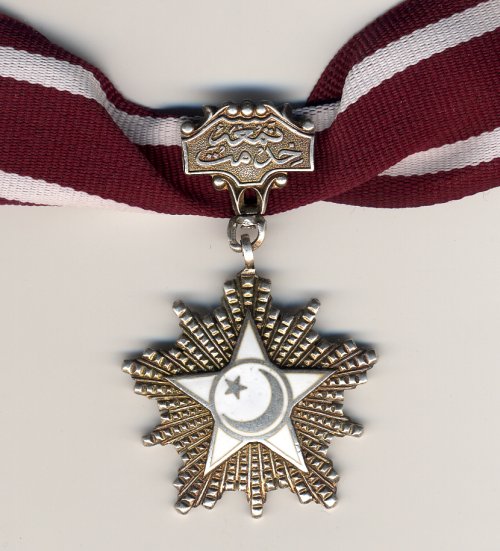
 0
0 -
2nd class (T.K.II) - A junior class to the T.K.I. Not to be awarded to those who already held the O.B.I. 2nd class. The decoration carried with it a monthly stipend of Rs. 25.
Roughly, this is the equivalent to the pre-1947 OBI 2nd class.
The first variety is a 47-mm silver faceted star with a five pointed star in the centre. The points of the star are enameled white with an unenameled star and crescent in the centre. It is suspended from a crimson ribbon with two white stripes by a tablet reading (in Urdu) "Tamgha-i-Khidmat".
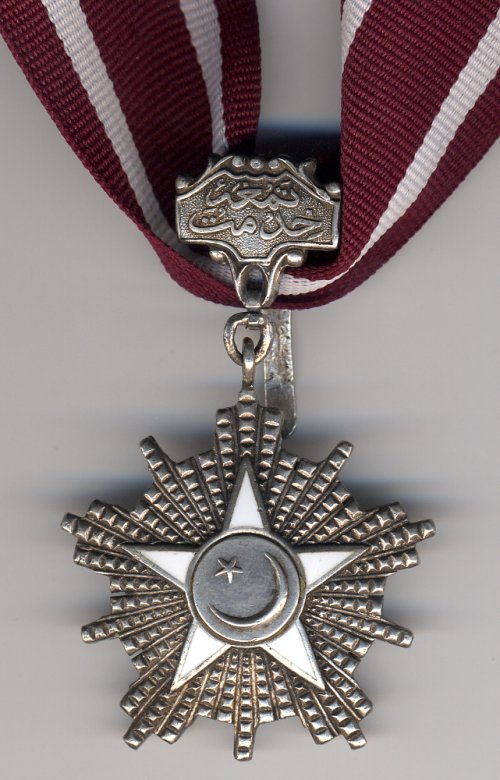
 0
0 -
The second variety is a 41-mm silver-gilt faceted star with a five pointed star in the centre. The points of the star are enameled white with a star and crescent in the centre, also on a white background. It is suspended from a crimson ribbon with a single white stripe by a tablet reading (in Urdu) "Tamgha-i-Khidmat".

 0
0 -
Tamgha-i-Khidmat (Military) / Medal of Service (Military)
This will take a while.
Awarded for long and meritorious service of a distinguished nature. Recipients of the award are entitled to use postnominal abbreviations as detailed below.
In many ways, this serves as a military class paralleling the Nishan-i-Khidmat; it is important to distinguish between this award and the Tamgah-i-Khidmat that is the fourth class of the Nishan-i-Khidmat. This decoration also represented somewhat of an overlap with the older, pre-1947, Order of British India and no soldier could be awarded the Tamgha-i-Khidmat who held the O.B.I. 1st class.
These awards are widely and easily available in Pakistan and are often added to "augment" invented groups. Be aware and be cautious.
Established: No.F.40(3)/Pres./57 of 16 March 1957, by the President of Pakistan. At some point in time -- unknown at present -- the badge was redesigned.
Obverse: A ten-pointed faceted star (metals and design vary by variety and by class, see below) with a superimposed five-pointed white-enameled star with a star and crescent in the center. Suspended as a neck badge from a suspender with the name of the decoration ?Tamgha-i-Khidmat?.
Reverse: A circle; the medal is sometimes named here, though not always "officially"
Ribbon: Basically crimson and white, but it differs by class; see detailed comments below.
1st class (T.K.I) - Awarded only to those who held the T.K.II or O.B.I. 2nd class. The award carried a monthly stipend of Rs. 40. On retirement, the awardee was to be granted the rank of Honorary Captain (if a Risaldar-Major or Subadar-Major) or Honorary Lieutenant (if a Risaldar, Subadar, or Jemadar).
Roughly, this is the equivalent to the pre-1947 OBI 1st class.
The first variety is a 47-mm silver-gilt faceted star with a five pointed star in the centre. The points of the star are enameled white with an unenameled star and crescent in the centre. It is suspended from a crimson ribbon with a single white stripe by a tablet reading (in Urdu) "Tamgha-i-Khidmat".
1st class (T.K.I) - Awarded only to those who held the T.K.II or O.B.I. 2nd class. The award carried a monthly stipend of Rs. 40. On retirement, the awardee was to be granted the rank of Honorary Captain (if a Risaldar-Major or Subadar-Major) or Honorary Lieutenant (if a Risaldar, Subadar, or Jemadar).
Roughly, this is the equivalent to the pre-1947 OBI 1st class.
The first variety is a 47-mm silver-gilt faceted star with a five pointed star in the centre. The points of the star are enameled white with an unenameled star and crescent in the centre. It is suspended from a crimson ribbon with a single white stripe by a tablet reading (in Urdu) "Tamgha-i-Khidmat".
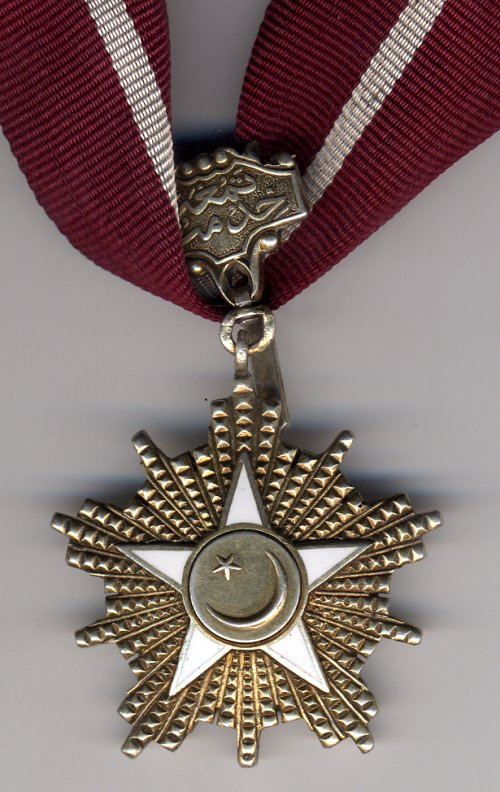
 0
0 -
Quaid-i-Azam Police Medal for Bravery
Named to "Rana Maqbool Ahmed, Q. Azam Police Medal".
This is a rather controversial figure, to say the least, in contemporary Pakistani history.
Appointed IG of Police, Sind, in October 1998 (he was previously DIG Police, Karachi). He was among the most junior of DIGs and the press widely speculated on political intervention by Prime Minister Nawaz Sharif. It was also relevant, perhaps, that he was a Punjabi taking over police operations in Sind. This promotion was challenged in court in February 1999. Many changes had also been brought forward of use of excessive violence, including extra-judicial killings, by the IG against Sindi political parties (especially MQM) unfriendly to the prime minister. This led to growing attackes by the MQM against him as "one of the most corrupt Punjab police officers . . . [with a] shady past" (http://www.mqm.com/English-News/Oct-1999/news-1999-10-24a.htm).
In January 2000, Rana Maqbool Ahmed was brought up on charges of accessory to hijacking and accessory to treason in the attempted diversion the aircraft carrying of General Pervez Musharraf on 12 October 1999. Ex-Prime Minister Nawaz Sharif was, of course, the main target in this case. The IG had ordered police to take control of Karachi airport and, had the scheme succeeded, it would have been his task to arrest the general. Ahmed was, eventually, found innocent on these charges, but his police career was over (though charges of corruption still occasionally surface).
It is unknown, at present, what he did to get this medal, but there is obviously a story surrounding it.
Wow.
Ed
(PS- ribbon incorrect - can anyone help?)
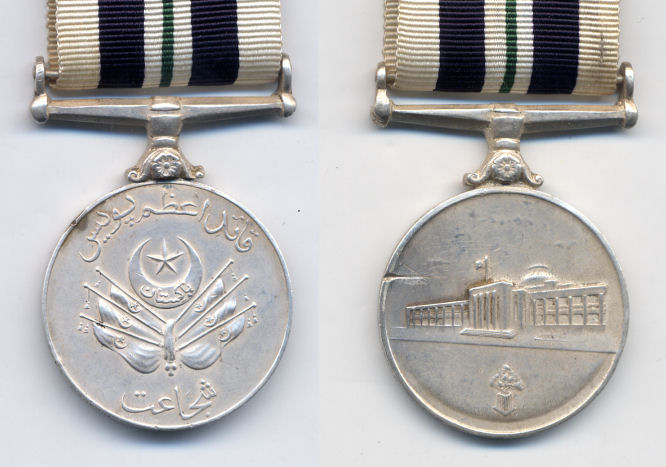
 0
0 -
Tamgha-i-Jur?at / Medal of Courage
Awarded to non-commissioned officers and enlisted men for gallantry and distinguished services in the face of the enemy. The award carried the right to use the postnominal abbreviation T.J. and, for non-commissioned officers and enlisted men, a monthly allowance of Rs. 15. The decoration is roughly comparable to the British Distinguished Conduct Medal. Created by No.F.40(3)/Pres/57 of 16 March 1957.
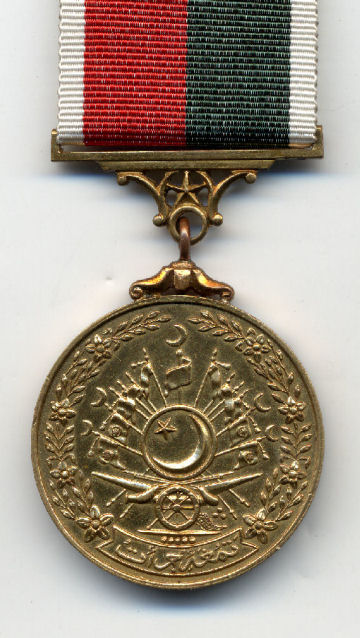
 0
0 -
Hilal-i-Jur?at / Crescent of Courage
Awarded to officers for acts of valor, courage, or devotion to duty in the face of the enemy. The award carried the right to use the postnominal abbreviation H.J. This decoration is a rough equivalent to the British Distinguished Service Order. Established by No.F.40(3)/Pres./57 of 16 March 1957.
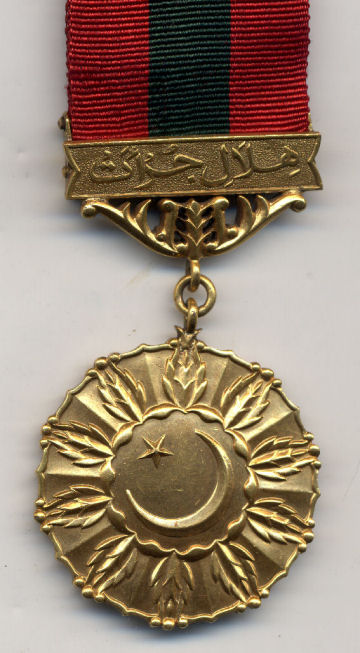
 0
0 -
Sitara-i-Jurat / Star of Courage
PA-1929 Lt.-Col. Abdul Rahman, SiJ, Artillery
Posthumous, 11 September 1965
Lt-Col 'Chota' Abdul Rahman was commanding 1 (SP) Arty and was forced to act as forward Observation Officer when his unit was taken unawares. It is said that he showed a blatent disregard for his own safety by taking up a position on the high ground in advance of his guns, and by exposing himself to heavy fire set a magnificant example to his men and those around him. From this vantage point he accurately directed fire upon the approaching Indian Armour, his guns destroying three tanks with the first three rounds fired. This is said to have turned the Indian attack away from the weakest part of the Pakistani lines. Chota was killed the next day when communicating firing orders from the FFFs Command vehicle.
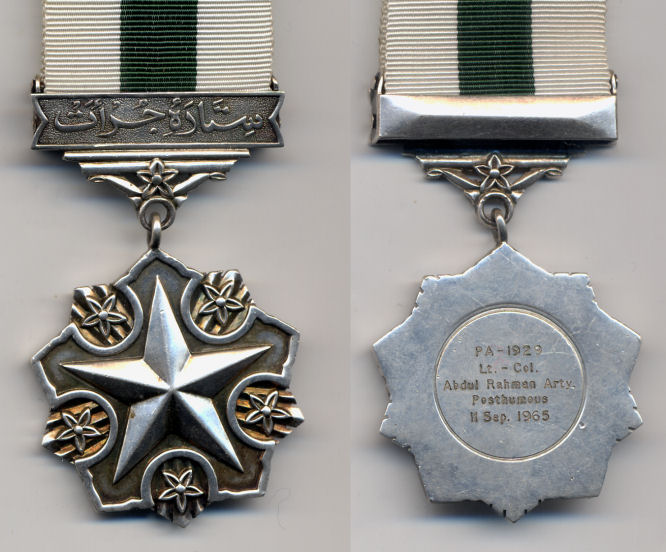
 0
0 -
Pakistan medals . . . ??
You want Pakistan medals . . . ??
I hope you know what you have started here, Mike?!
See also: http://sagongs.ipbhost.com/index.php?c=5
0 -
Actually, I think my only ones are up already. May I link:
http://gmic.co.uk/index.php?showtopic=2735 (need to get more of her documents up)
http://gmic.co.uk/index.php?showtopic=2734
Now, if you want to talk labor awards, . . .
0 -
I was going to post some of mine. Don't think I'll bother now.




 0
0 -
Very curious . . . much to ponder.
0 -
I have the refoundation text in German.
It can be laboriously retyped, but
this is a COMPLETE MISUNDERSTANDING of the paraphrased original German text.
German awards were not made posthumously except in extremely unusual circumstances.
There were never automatic posthumous Iron Crosses. Ever.
Thank you Rick. No need to retype. We take your word for it.
 0
0 -
Ahhh--
if only we could see the royal files burnt before August 1947?
Perhaps, it would be nice. Gone-gone. The Brits burned much before transferring power, an episode of malicious archival clear-cutting. The next step will be to look at the records of the States themselves (though some major ones are gone -- Patiala -- and others are off-limnits -- Kashmir). Shall attempt this this summer. Any government may not keep records on much, but they'll keep records on those things they spend money on. Like gongs?
0 -
Chris,
As quoted in "The Iron Time" by Stephen Previtera on page 159.
"The Iron Cross is to be awarded without exception to all persons of the Army, Navy and Home Guard, members of volunteer nursing units and to all other persons who offer their service to the Army or Navy or who are designated as Army or Navy officers. The award will be given for every sacrifice made during the war. Further, all persons who earn it by serving the needs of the German Empire and it's allies at home may receive the cross"
Is this Perevitera speaking or is he quoting an original source? If so, what is that? This can always be a problem when normal citation form is abandoned. I won't characterise this practice further.
As I always try to teach my students, quoting a secondary source means comparatively little, only quoting a primary source is valid and valuable. They rarely learn this (either).
0 -
yowie!


nice!!!
0 -
Some more proncial NIBs
The first, from Umnugobi, seems a later and a MUCH lower quality version of the badge discussed above at http://gmic.co.uk/index.php?showtopic=5914&st=39 .
The second seems to be a 60th anniversary badge for Tuv province.
The third one appears to be some sort of anniversary badge from Arkhangai.
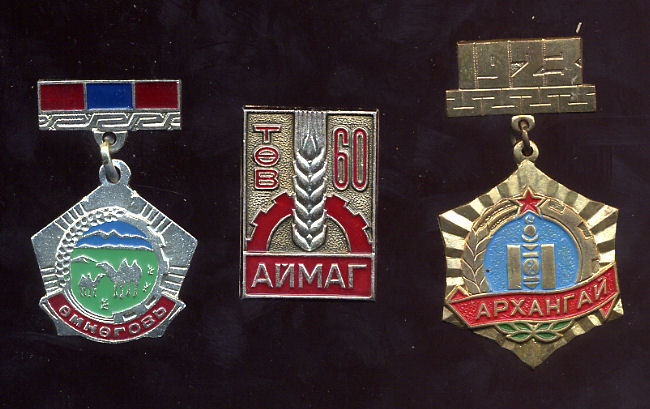
 0
0 -
Keep on truckin' (and bussin') NIBs
I would guess the first two are linked to the 60th anniversary of road transport, while the third might be linked to the 30th anniversary of bus transport. This is, of course, no more than uninformed guesswork!
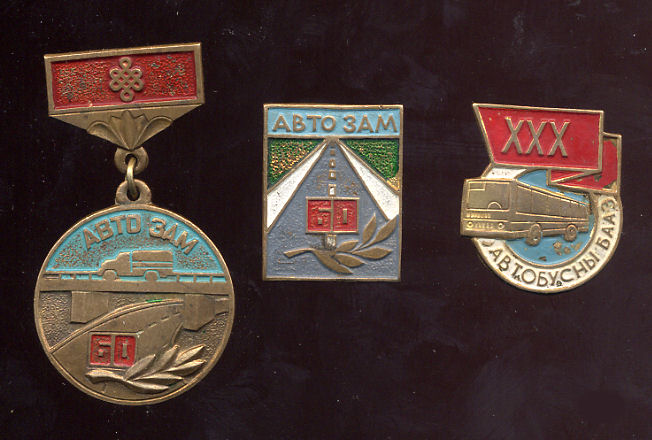
 0
0 -
MRYL NIBs
Two NIBs from the Mongolian Revolutionary Youth League.
Would guess the first is for the 18th meeting/conclave/jamboree of the MYRL. And, yes, it is as large as it looks, some 63 x 40 mm.
Would guess the second is for the 60th anniversary of the MYRL, 1981.
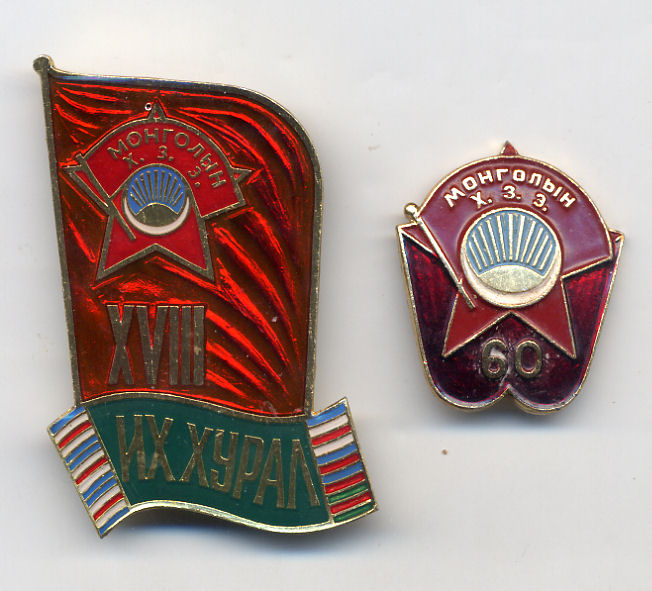
 0
0 -
Zavkhan and Selenge NIBs
Would guess the first is for the 60th anniversary of the Zavkhan province.
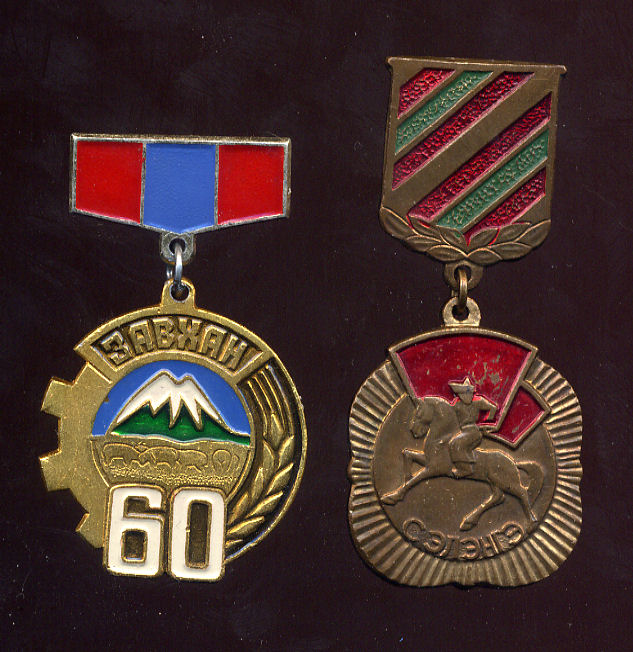
 0
0 -
Wrestling NIBs
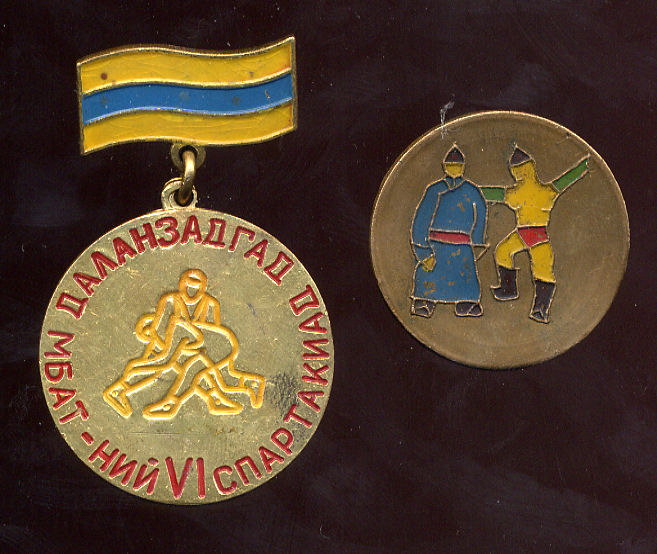
 0
0 -
Another Dornod NIB
For ploughing some something similar?
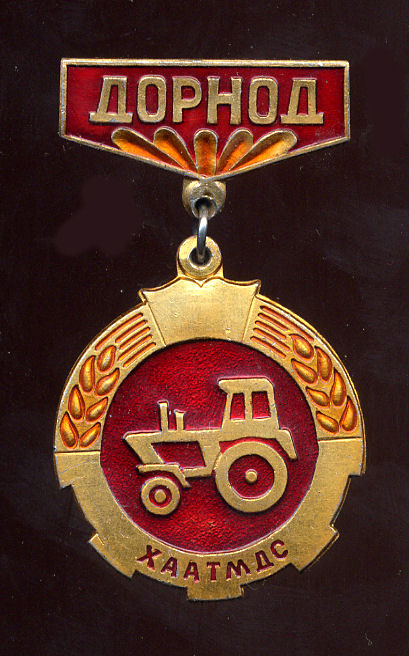
 0
0 -
Dornod NIB
From Dornod province.
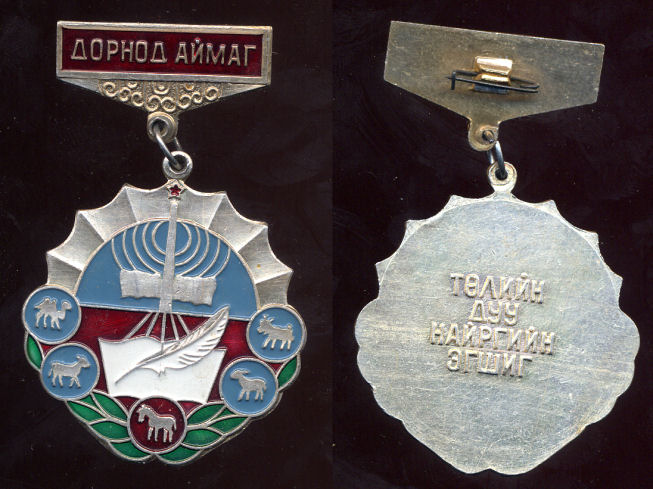
 0
0 -
Friendly NIBs
Would guess the first is for the 40th anniversary of the Soviet-Mongolian Friendship Society.
Others . . . ???
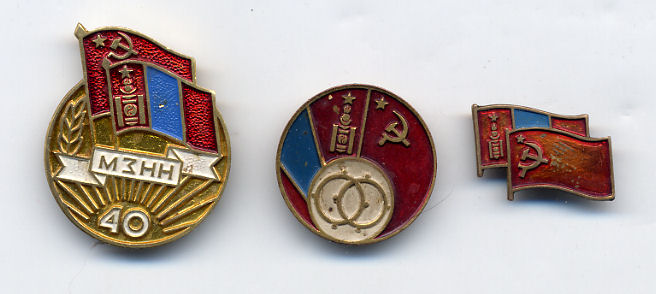
 0
0




Pakistan Medals
in South Asia
Posted
3rd class (T.K.III) - Roughly, this is the equivalent to the pre-1947 OBI 3rd class (approved in principle, but never notified or awarded).
The first variety is a 47-mm bronze faceted star with a five pointed star in the centre. The points of the star are enameled white with an unenameled star and crescent in the centre. It is suspended from a crimson ribbon with three white stripes by a tablet reading (in Urdu) "Tamgha-i-Khidmat".